
The Kawasaki Ninja 250R (previous generations had market-specific names) is a motorcycle originally introduced by Kawasaki in 1983. As the marque's entry-level sport bike,[1][2] The motorcycle has undergone few changes throughout its quarter-century lifetime, having received only two substantial redesigns.
Kawasaki Ninja 250R
Prices and Review
On Road Price
Rs. 3,08,600
* Mumbai. May vary.
OUR RATINGS
Appearance: ----------------------O O O O O
Comfort: --------------------------O O O O O
Features: --------------------------O O O O O
Performance: --------------------- O O O O O
Value for money: ------------------O O O O O
Displacement: 249cc
Engine: Four-stroke, Parallel Twin, DOHC
Maximum Power: 32.5 Bhp @ 11000 rpm
Maximum Torque: 22 Nm @ 8200 rpm
Gears: 6 Manual
Clutch: Wet Multi-Disc, Manual
Bore: 62
Stroke: 41.2
No. of Cylinders: 2
Cylinder Configuration: Parallel Twin
Valve Per Cylinder: 4
Engine Block Material: Steel
Chassis Type: Semi-double cradle, high-tensile steel
Cooling Type: Liquid Cooling
Carburetor: No, It Is Fuel Injected
DIMENSIONS
Length: 2085.00 mm
Width: 715.00 mm
Height: 1115.00 mm
OTHER SPECIFICATIONS
Weight: 172.00 kg
Ground Clearance: 135.00 mm
Fuel Tank: 17.00 ltrs
Wheelbase: 1400.00 mm
Headlamp: Halogen
Wheel Type: Black Mag Alloys
Wheel Size: 110/70 R17-130/70 R17 mm
Tubeless:
Colors: Lime Green, Ebony Black
ACTIVE AND PASSIVE SAFETY
Suspension(Front): 37mm hydraulic telescopic fork
Suspension(Rear): Uni-Trak with aluminum linkage
Brakes: 290mm Petal Disc
Brakes(Rear): 220mm Petal Disc
Stand Alarm:
COMFORT AND CONVENIENCE
Suspension(Rear): Uni-Trak with aluminum linkage
Brakes: 290mm Petal Disc
Brakes(Rear): 220mm Petal Disc
Stand Alarm:
COMFORT AND CONVENIENCE
kawazaki ninja 250r seat comfort :
Fuel Guage: Analogue
Self Start:.............................................. o
Tacho Meter: Analogue
Trip Meter: Analogue-1
Alloys: 0
Warranty: 12 months
Speedometer: Analogue
Passenger Footrest: o
Passenger Backrest: o
Step-up Seat: o
Pass-light: o
Low Fuel Indicator: o
Low Oil Indicator: o
Low Battery Indicator: o
High Oil Temp. Indicator: o
Choked Air Filter Indicator: o
Nomenclature
The fourth-generation model is marketed as the Ninja 250R in all markets. The motorcycle is also referred to by its platform designation, EX250, to which a generational suffix is attached. In the United States, previous generations of the bike (EX250-E/F/G/H) were already being marketed as members of the Ninja family of sport bikes, while outside of the U.S. the bike was known variously as the ZZR-250, ZX-250, or as the GPX-250R. One of the earliest generations, the EX250-C, was given the name GPZ-250.
Description and features
The Ninja 250R's particular ergonomics, chassis design, and engine placement have resulted in a motorcycle that straddles the standard and sport classes. The Ninja's riding posture also falls somewhere between standard and sport. The bike is capable of running the quarter mile in 15.58 s @ 81.98 mph (131.93 km/h),[3] although it had been 1 s faster in the prior generation, [4] while providing the amenities of more utilitarian motorcycles, including bungee hooks for transporting cargo and space for a second passenger.
The latest model, the EX250-J or fourth generation, brought the Ninja's first major update in many years. Appearance upgrades included 17-inch wheels and completely redesigned fairings which give the motorcycle a sleeker, more modern appearance.
First generation
The first generation was produced between 1983 and 1984, and known by the production number EX250-C. It was sold as the GPZ-250. Sold only in its home market of Japan, this earliest, belt-driven version was first produced in 1983, and shares no commonality with later generations.[citation needed] The bike has 35mm fork tubes.
Second generation
Produced between 1986 and 1987 was the EX250-E. This model was sold as the Ninja 250R in Canada and the U.S. between 1986 and 1987. It was known as the GPZ-250R elsewhere. When originally introduced, it was more costly than the Honda Rebel, and reviewers complained that while the 14,000 rpm redline was nice, the engine was slow to rev.[5]
Third generation
For the 1988 model year, there were both cosmetic changes and changes in engine tuning. While the bore and stroke, and other major engine components, were unchanged, minor tuning adjustments were made. The carburetor diameters were reduced 2 mm to 30 mm (1.2 in), the cylinder compression ratio was increased from 12.0:1 to 12.4:1, ignition timing advance was increased, and the rear sprocket was increased by three teeth to 45.[4][6][7] Reviewers reported that this made the engine more free-revving, reaching the high 14,000 redline more quickly, and the tested top speed increased by a few miles per hour.[4][5][8] The new, more fully-enclosed bodywork was complimented for being stylish, at the time, and easily mistaken for the larger Ninja 750.[5]
The third generation of production of the Ninja 250 encompassed three models:
EX250-F - The most widespread EX250 variant, the E model was completely revamped and sold as the F model between 1988 and 2007 in the United States. Canada received the model between 1988 and 1999, and it was available elsewhere as the GPX-250R as early as 1987.
EX250-G - Sold only in its home market of Japan, this version was known as the GPX-250R-II. It featured dual front brakes and a wider wheel and tire (110/80-16). All other parts were identical to the -F model. It was sold after 1988.
EX250-H - This model came to Canada as the Ninja 250R between 2000 and 2002, after which it received a new name: ZZR-250, in line with the -H model's name elsewhere in the world, where it had existed since 1992. This motorcycle has few parts in common with the -F model, though it shares the same engine, albeit with different casings. It sports a lateral aluminum frame, a different fairing (designed to make it look sportier), larger 17-inch wheels, an adjustable rear shock absorber, adjustable brake and clutch levers, a smaller drive sprocket, computer-controlled timing advance, and a revised electrical system.[citation needed]
Fourth generation
In 2008, Kawasaki gave the EX250 its most thorough modernization in many years. The EX250-J model is known as the Ninja 250R worldwide, regardless of market.
Parts from the third generation are still found on the -J, but its redesigned exterior panels bring the Ninja's appearance out of the 1990s and into line with late-2000s sportbikes. The engine and drivetrain retain 30% of the -F model's parts, according to Kawasaki.[citation needed] The engine's compression and maximum torque have been lowered to provide better midrange performance. The redesign of the engine resulted in improvements in engine response at low engine speeds, and making the bike smoother and "much easier to ride."[11] Though the previous generation Ninja 250 had a peak power advantage of 1 to 5 hp (0.75 to 3.7 kW),[7][12][13] the new version's 20 or 30 percent increase in mid-range power allows the bike to pull from 3,000 rpm where previously it had to be revved to 4,000 rpm.[3] The U.S. -J model uses dual carburetors like the -F model, but the European, Brazilian and Thai models have fuel injection. The wheels were increased in size to 17 inches, the front suspension was improved, and the brake rotors were replaced with a larger petal shape. On the carbureted version, a fuel gauge was added in place of the temperature gauge. With the additional and redesigned equipment, the EX250-J suffered a 10 kg (22 lb) increase in wet weight over its predecessors.
With the arrival of the EX250-J, manufacturing continues to be located in Thailand.[14]
kawazaki ninja 250 colours
250cc with 32bhp@11000rpm
kawazaki ninja250r and Honda CBR
feel the difference
2011 HONDA CBR250R VS 2011 KAWASAKI NINJA 250R SPEC COMPARO!
With a 250cc, liquid cooled-parallel twin motor nestling under it’s fairing, the Ninja 250R was quicker than every other Indian motorcycle to top out at 160 Kph and while at that, cross the 100 kph mark in about 7 seconds. Sweet handling and an easy to ride posture meant that the Kawasaki Ninja was as much home on the track as it was munching miles as a long distance sport tourer.
2011 Honda CBR250R
Time does move on and two summers down the line, the Ninja 250R finally gets competition, and some really serious stuff at that. Honda has readied up it’s latest global 250cc entry level motorcycle challenger, the 2011 Honda CBR250R. Honda Motorcycles and Scooters India opted for a low key launch by just sending across the prices to us.
2011 Kawasaki Ninja 250R
While this was due to the sad set of events at Japan over the last couple of weeks, the motorcycle in itself has garnered tremendous response from Indian motorcycle enthusiasts young and old alike. One reason for this of course is the fact that the CBR250R comes with a technology laden 250cc liquid cooled, DOHC, four valve engine that pumps our 25 Bhp of Power and 23 Nm of Torque.
2011 Honda CBR250R
While the power is lesser than the Kawasaki Ninja, the Honda pips the Kawasaki in the torque stakes. So, in essence, the Ninja 250R, loves to be revved to keep things on the boil while the Honda CBR250R will offer the same thrills at lower rpms. This, on paper at least translates into better drivability in trafficated Indian conditions where high revs could get you plastered onto a slow moving Bus’ behind if you aren’t careful enough.
2011 Kawasaki Ninja 250R
Given the stick, the Honda CBR250R can be pretty rapid, but just a little slower than the Ninja when it comes to outright performance stakes as the Ninja’s extra cylinder gives it that edge when it comes to all out performance. What the Honda CBR250R could also gain is on the fuel economy front where the more torquier Honda engine could pip the high strung Ninja motor.
2011 Honda CBR250R
Also, being lighter than the Ninja by almost 12 kilograms for the Non-ABS CBR250R, the difference in both performance and fuel economy of the CBR250R shouldn’t be much with the CBR having an edge in economy. When it comes to styling though, as a personal preference, I’d pick the Ninja 250R over the CBR250R, which to me looks boring. But since that is pretty subjective, let’s get a move on.
2011 Kawasaki Ninja 250R
The Kawasaki Ninja 250R sells 50-60 units every month and costs almost INR 3.2 Lakhs on-road Pune. On the other hand, Honda has already garnered 2000+ bookings for the 2011 CBR250R even before the first crop of motorcycles are out on the streets. This is a clear indicator that the CBR250R is a clear winner on the Value-For-Money stakes as it is prices at approximately INR 1.7 Lakhs on Road Pune for the non-ABS version and INR 2 Lakhs for the C-ABS version.
2011 Honda CBR250R
This is something that the Ninja 250R can never match as the CBR being built in India grounds up has a huge advantage when compared to the Ninja, which is assembled at Bajaj’s Chakan plant through the CKD route. And that factor simply seals the advantage for the CBR250R in the Indian market. Meanwhile, here’s a head to head comparo between the 2011 Honda CBR250R and the 2011 Kawasaki Ninja 250R.
COMPARISON OF CBR 250R WITH NINJA 250R
COMPARISON OF FEATURES:
CBR 250 R :
Introducing with new front sporty firing and sharp rear look.
A multi functional digital instrument which include
Speedometer
Tachometer
Engine temperature display
Fuel gauge multi segment
Odometer ,Trip meter ,Clock
LCD Blue back light
First time in 250 cc segment that CBR C-ABS version that is combined anti breaking system (Its as optional that it comes without ABS also)
Advanced PGM Fi engine which is programmed fuel injection system.
It comes with liquid cool 4 valve engine.
Advanced diamond twin spar steel frame.
An external fuel fuel filter for easy maintenance and increases the tank capacity too.
Both front and rear disc breaking.
Well designed seating for rider and pillion.
A handy under seat storage.
Optional accessories that Tail pack,wheel rim sticker,tank protection .
Well positioning of handle for sporty riding.
NINJA 250 R :
The main thing which attracts ninja 250 is it comes with low price compare to other 250.
This ninja is of UNI TRACK at rear suspension.
It has large pedal disc in front of 290 mm rear pedal disc of 220mm.
The engine made up of gas sipping twin cylinder technology for good performance.
The vehicle is light weight which feels comfortable to ride.
Very much comfortable and smooth 6 peed gearing feels easy on gear shifting.
Its learner friendly and user friendly in low and mid range torque by dual over head camshaft and by 2 into 1 exhaust system.
The ninja 250R is very good in its fuel economy.
The wind screen and fairing looks great and gives wind protection in wide range riding.
The dual catalyze one at the collector pipe and other one in the silencer minimizes the emission.
Its very good in its throttle response.
The ninja engine is of liquid cool offers superior cooling.
The friction plates are made up of papers base helps in the durability of clutch.
The 5 way adjustable rear shock and a telescopic front fork helps in smooth riding.
On the rear seat they have provided a small storage space.
Its of all analog meters that is speedometer, tachometer,odometer,trip meter and fuel gauge.
Superb looking split head light with dual lamp gives great looks to ninja.
COMPARISON OF PERFORMANCE :
CBR 250 R :
CBR 249. 4 cc 4 stroke, 4 valve DOHC,water cooled engine delivers a maximum power of 26.4 bhp @ 8500 rpm.
And a maximum torque of 22.9 Nm @ 7000 rpm .
The PGM FI programmed furl injection system ensure smooth and Exact delivery result in delivering power with less consumption.
The engine spares are light weight with good quality and durability.
The liquid cooling reduces over heating and ensure the engine temperature at recommended level .
The fuel filter which is out side the tank reduces the maintenance cost.
It comes with 6 speed gear which feel free and comfortable to shift gear in city or on highway.
The silencer with catalyst metal tri limit to exhaust the minimum emission.
The twin spar steel diamond frame which is enough stiffer for handling and stability.
CBR comes with front hydraulic suspension and a rear mono suspension for excellent riding quality.
The new technology for CBR 250 is that C ABS ( combined anti breaking system) for for effective breaking control, its the combination of front and rear breaking.
It comes with front 296 mm disc and rear with a 220 mm disc.
Its optional that for C ABS the kerb weight will increased by 4 kg.
NINJA 250 R :
The power full engine 250 delivers a maximum power of 33 PS @ 11000 rpm.
And a maximum torque of 22 Nm @ 8200 rpm.
The 2 into 1 exhaust system helps at low and mid range torque and the smooth power delivery.
The two catalyze helps in the exhaust system help in reducing the power loss.The good off ideal response and smooth power delivery is contributed by intake and exhaust port.
It ensures reliable high rpm by direct actuation valve system.
Very good in mass centralization and excellent handling by compact parallel twin design.
The CVK30 carburetors from Kawasaki helps in low fuel consumption and very good power.
The denso radiator helps in excellent cooling of engine at higher rpm and also from ring fan.
On the time of gear shifting the spring type clutch reduces the jerking.
The diamond style frame thick steel tubing assure you the confidence and stability.
The front telescopic and rear UNI TRACK suspension make you to feel the comfort on ride.
The front large 290 mm disc of two piston caliper and rear 220 mm of two caliper gives out excellent breaking.
The overall the light weight ninja is very good in its version and gives very good mileage also.
COMPARISON OF MILEAGE :
CBR 250 R :
It may give 25-30 kmpl in mileage
NINJA 250 R :
It give the mileage of 20 km pl
COMPARISON OF PRICE :
CBR 250 R :
The price may vary it may be with in 1.5 lks.
NINJA 250 R:
The price of ninja 2,97,000.00
COMPARISON OF ADVANTAGES:
CBR 250 R :
PGM FI Engine.
Comes with C ABS technology as optional.
Liquid cooled engine.
Well designed quality.
comes with front and rear disc.
NINJA 250 R :
Light weight and nimble.
Good power and fast.
and its economical vehicle.
comes with both front and rear disc
Its faster compare CBR 250
COMPARISON OF DISADVANTAGES :
CBR 250 R :
Cost of the bike.
When comes to mileage.
NINJA 250 R :
Unreliable.
Poor in resale value.
doesn’t comes with C ABS technology
2011 Honda CBR 250R vs 2010/11 Kawasaki Ninja 250R :
Come April, 2011, and there would be a war for a throne which was being commanded by the Kawasaki Ninja 250R for the past more than one year. The challenger.... the new for the calendar year 2011, Honda CBR 250R. But will the Honda CBR 250R have enough steam to de-throne the mighty Ninja which has had an experience of more than 20 years of being the best in the class?
Well, let's have a look at how the specs for both the bikes compare up
Three major differences between the engines of both the machines are -
The Bore x Stroke ratio
The Compression ratio
Peak Power output
Peak Torque output
The Bore x Stroke Ratio :
As can be very clearly seen that with a Bore x Stroke ratio of 76 x 55 mm (1.381:1) the Honda CBR 250R engine is slightly lower than that of the Kawasaki Ninja 250R at 62 x 41.2 mm (1.504:1), which means that the peak torque of the Honda CBR 250R would be coming at slightly lower rpms than the Kawasaki Ninja 250R. A quick look at the peak torque figures proves the point, as the CBR 250R develops it's peak torque at 8000 rpms and the Ninja 250R develops it's peak torque at 8200 rpms.
The Compression Ratio :
The Kawasaki Ninja 250R with a compression ratio of 11.6:1, gains over the Honda CBR 250R which has a compression ratio 10.7:1. This means that the Ninja 250R has better thermal efficiency and is able to extract more mechanical energy from a given mass of air-fuel mixture. This translates into the fact that the Ninja 250R would be able to build speeds quicker than the CBR 250R.
Peak Power Output :
Clearly, with it's Parallel Twin configuration and higher compression ratio, the Kawasaki Ninja 250R wins over the Honda CBR 250R by a handsome margin. But here we need to consider the fact that even though running on a single cylinder mill, the Honda is generating a very healthy power number, but the Ninja clearly zips ahead by numbers. Just imagine what fun it would have been to ride the Honda CBR 250RR, producing 40 HP at 14500 rpm, with Transverse four cylinder DOHC motor (with some contemporary styling of-course)!!
Peak Torque :
Even though a single cylinder motor, the CBR 250R with 22.9 Nm Torque at 8000 rpm generates marginally more torque than the Ninja 250R with 22 Nm Torque at 8200 rpm. So, clearly the CBR is higher on torque than the Ninja with it's configuration. So, apart from the engine, the most visible and prominent difference between the Kawasaki Ninja 250R and the Honda CBR 250R is the presence of optional C-ABS on the later. This, from my point of view is a great feature to have in any motorcycle and going by the reviews I've heard from people owning the Honda CBR 1000RR Fireblade with the C-ABS feature, this thing works like magic and is very confidence inspiring. So, price factor apart, anyone who decides to go for the Honda CBR 250R, must go for the C-ABS version of the bike, it's worth every extra penny shelled out.
Finally
So, what's the result of the comparison? Well, it's very evident that the Kawasaki Ninja 250R is the more radical of the two and is more performance oriented. The Honda CBR 250R is more on the relaxed touring side and is actually a deflection from it's CBR tag genome. For 2011, the Honda CBR 250R definitely looks refreshing and the given the price tag and the fact that it would be manufactured in India, the bike would definitely find it's share of moolah domestically, and might also succeed in making inroads into the market share of the Kawasaki Ninja 250R, but the big question lies in the realization of the fact that will 26.4 HP be able to satiate the performance apatite the presence of a very succulent 33 PS? Well, India is a very sentimental country, you never know what's next :)
Redish kawasaki ninja 250r
Photo gallery only for ninja lovers
Greenish kawazaki Ninja 250r
photo gallery only for ninja lovers
Blackish kawazaki ninja 250r
photo gallary only for ninja lovers
Kawazaki Ninja 250r Photo Gallary
Only for Ninja Lovers
follow this blogger and download
By
Ninja Lovers























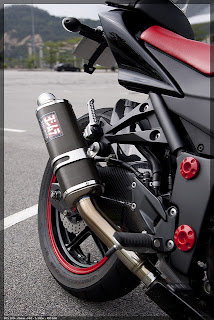











































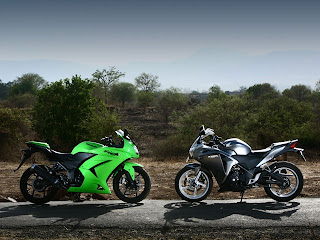













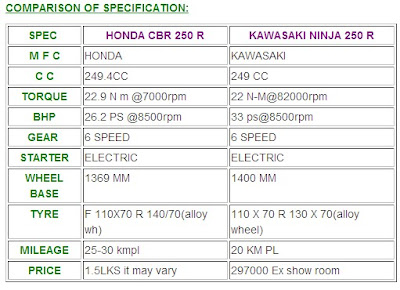










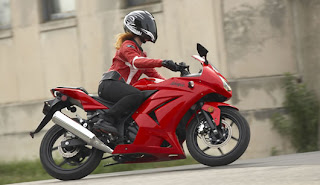

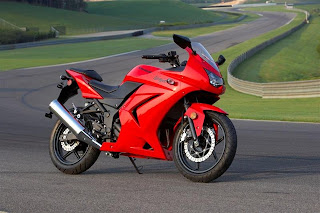










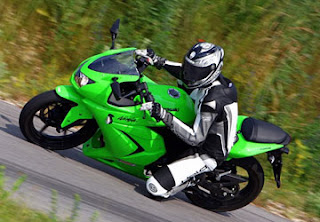















Kawasaki Ninja 250 is the best looking sports bike. Kawasaki Ninja 250 can complete 0-60 km/h in just 3.1 seconds and 0-100 km/h in mere 8.1 seconds and it gives 42 kmpl mileage.
ReplyDelete